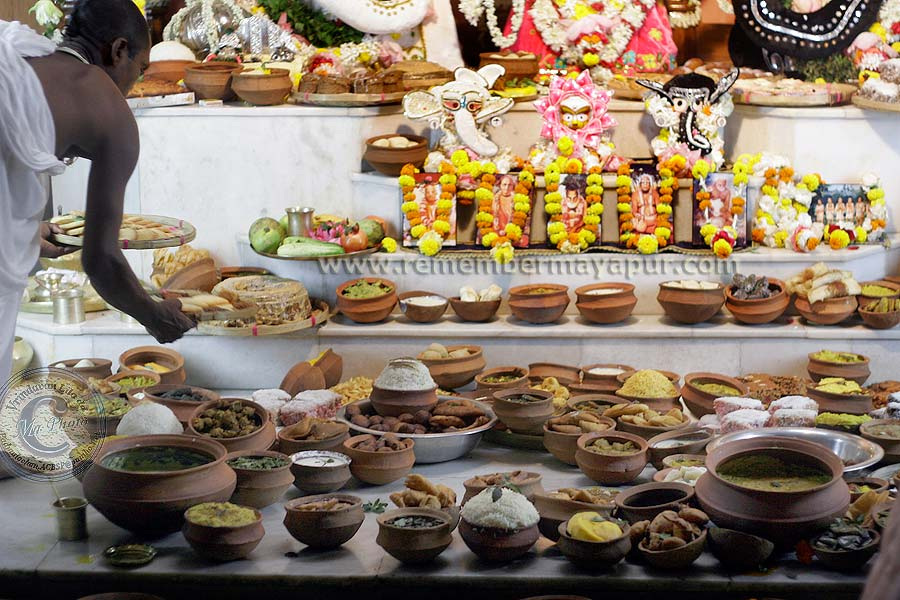
More classic art masterpieces used as illustrations
TL;DR:
A Christian in South India, Ramamurti, faces a dilemma when his Hindu coworker offers him food (prasadam) that had been dedicated to the god Krishna during a shrine ceremony at their workplace. Accepting it would build goodwill, but that could also be interpreted as participating in idol worship. The case study highlights tensions between interfaith respect, evangelistic witness, and religious identity, paralleling the Apostle Paul’s discussion of food offered to idols in 1 Corinthians.

Ramamurti, who was a Christian, looked across the room at the group of printing press workers. They were gathered around the large image of the blue-faced Hindu god Krishna, who had been heavily garlanded with marigolds and tinsel. Ramamurti looked at the plate of food that had just been taken from in front of the god and was now being offered to him. What should he do?

Image of Lord Krishna
It was Friday, and Ramamurti realized that he had arrived just at the completion of weekly prayers to Krishna, the Hindu deity who was revered as the patron of the printing press. Like many businessmen in this city in South India, the printing shop owner provided money out of his pocket for employees to purchase coconuts, bananas, and sugar to offer at the weekly puja ceremony (Hinduism's worship ritual).
The print shop where Ramamurti had just arrived was doing well. The owner believed that the prosperity of his printing plant was a sign of divine blessing because of his faithful offerings to the god.
As assistant editor of a Christian magazine, Ramamurti was responsible for seeing that the publication was properly printed and came out on schedule. Today, he had several urgent matters to take care of, so he came to the print shop earlier than usual. Before realizing that the puja ceremony was still going on, Ramamurti had hurried into the room, and the press foreman, Ravi, had seen him.
As they had worked together over the past months, Ravi and Ramamurti had developed a close relationship. Ramamurti hoped to win Ravi to faith in Jesus Christ someday. Right now, however, things seemed to be going in the opposite direction. Ramamurti's friend was pulling him toward the group receiving food that had been offered to Krishna at the little shrine in the print shop.
After each person had eaten, they had a spot of kumkuma (colored powder) placed on their foreheads. That colored spot signified that they had been purified by eating the god's leftovers. Ramamurti knew that for Hindus like Ravi, eating food that had been offered to a god was a sign of goodwill. It was somewhat like the giving or receiving of a Christmas present. But Ramamurti also knew that, for orthodox Hindus, partaking of the food and applying the kumkuma powder was a worship ritual.
Ramamurti did not want to damage his relationship with Ravi. He also did not want to compromise his Christian convictions or interfere with his witness to the lordship of Jesus in his life. Ramamurti vaguely remembered Paul addressing a similar issue in one of his letters to the Corinthians. Ramamurti saw Ravi hold out the platter of food toward him, and he . . .
As you process this case study, do not simply decide what you would do in this situation. Decide what you think would be the proper course of action for Ramamurti, given his beliefs, passions, and life journey.
Seven steps to good case study use
This case study, as originally written by Simon P. David, appeared in Case Studies in Missions, edited by Paul and Frances Hiebert, © Baker Book House. Edited and used with permission. This case study may be reproduced only upon payment of a 35-cent per copy royalty to: Baker Book House, P.O. Box 6787, Grand Rapids, MI 49516 USA.
-- Howard Culbertson, hculbert@snu.edu
In Hinduism, offering food at a shrine, temple, or altar is a common religious practice known as prasadam or prasad. Prasadam food is considered to be sanctified or blessed by the deity to whom it was offered. Eating prasadam is believed to be spiritually purifying and imbued with the blessings and grace of the deity.
The significance of consuming prasadam lies in the belief that it not only nourishes the body, but also purifies the soul. By partaking in prasadam, devotees express their devotion, gratitude, and reverence to the deity. It is believed that consuming prasadam can bring blessings, protection, and spiritual growth.
Additionally, prasadam is often considered to be free from impurities and negative energies because it has been offered with pure intentions and devotion.